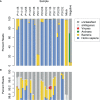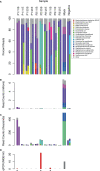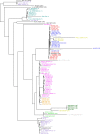Molecular Characterization of Microbiota in Cerebrospinal Fluid From Patients With CSF Shunt Infections Using Whole Genome Amplification Followed by Shotgun Sequencing
- PMID: 34490140
- PMCID: PMC8417900
- DOI: 10.3389/fcimb.2021.699506
Molecular Characterization of Microbiota in Cerebrospinal Fluid From Patients With CSF Shunt Infections Using Whole Genome Amplification Followed by Shotgun Sequencing
Abstract
Understanding the etiology of cerebrospinal fluid (CSF) shunt infections and reinfections requires detailed characterization of associated microorganisms. Traditionally, identification of bacteria present in the CSF has relied on culture methods, but recent studies have used high throughput sequencing of 16S rRNA genes. Here we evaluated the method of shotgun DNA sequencing for its potential to provide additional genomic information. CSF samples were collected from 3 patients near the beginning and end of each of 2 infection episodes. Extracted total DNA was sequenced by: (1) whole genome amplification followed by shotgun sequencing (WGA) and (2) high-throughput sequencing of the 16S rRNA V4 region (16S). Taxonomic assignments of sequences from WGA and 16S were compared with one another and with conventional microbiological cultures. While classification of bacteria was consistent among the 3 approaches, WGA provided additional insights into sample microbiological composition, such as showing relative abundances of microbial versus human DNA, identifying samples of questionable quality, and detecting significant viral load in some samples. One sample yielded sufficient non-human reads to allow assembly of a high-quality Staphylococcus epidermidis genome, denoted CLIMB1, which we characterized in terms of its MLST profile, gene complement (including putative antimicrobial resistance genes), and similarity to other annotated S. epidermidis genomes. Our results demonstrate that WGA directly applied to CSF is a valuable tool for the identification and genomic characterization of dominant microorganisms in CSF shunt infections, which can facilitate molecular approaches for the development of better diagnostic and treatment methods.
Keywords: CSF shunt infection; Staphylococcus epidermidis CLIMB1; cerebrospinal fluid; high throughput DNA sequencing; microbiota.
Copyright © 2021 Hodor, Pope, Whitlock, Hoffman, Limbrick, McDonald, Hauptman, Ojemann and Simon.
Conflict of interest statement
Author KW was employed by company New Harmony Statistical Consulting LLC. The remaining authors declare that the research was conducted in the absence of any commercial or financial relationships that could be construed as a potential conflict of interest.
Figures




Similar articles
-
Characterization of cerebrospinal fluid (CSF) microbiota from patients with CSF shunt infection and reinfection using high throughput sequencing of 16S ribosomal RNAgenes.PLoS One. 2021 Jan 6;16(1):e0244643. doi: 10.1371/journal.pone.0244643. eCollection 2021. PLoS One. 2021. PMID: 33406142 Free PMC article.
-
A Refined, Controlled 16S rRNA Gene Sequencing Approach Reveals Limited Detection of Cerebrospinal Fluid Microbiota in Children with Bacterial Meningitis.Microbiol Spectr. 2023 Jun 15;11(3):e0036123. doi: 10.1128/spectrum.00361-23. Epub 2023 May 4. Microbiol Spectr. 2023. PMID: 37140368 Free PMC article.
-
Evaluation of microbial bacterial and fungal diversity in cerebrospinal fluid shunt infection.PLoS One. 2014 Jan 8;9(1):e83229. doi: 10.1371/journal.pone.0083229. eCollection 2014. PLoS One. 2014. PMID: 24421877 Free PMC article.
-
Understanding and overcoming the pitfalls and biases of next-generation sequencing (NGS) methods for use in the routine clinical microbiological diagnostic laboratory.Eur J Clin Microbiol Infect Dis. 2019 Jun;38(6):1059-1070. doi: 10.1007/s10096-019-03520-3. Epub 2019 Mar 5. Eur J Clin Microbiol Infect Dis. 2019. PMID: 30834996 Free PMC article. Review.
-
Profiling of Oral Bacterial Communities.J Dent Res. 2020 Jun;99(6):621-629. doi: 10.1177/0022034520914594. Epub 2020 Apr 14. J Dent Res. 2020. PMID: 32286907 Free PMC article. Review.
Cited by
-
From Conventional Detection to Point-of-care Tests (POCT) Method for Pediatric Respiratory Infections Diagnosis: A Systematic Review.Arch Iran Med. 2025 Feb 1;28(2):112-123. doi: 10.34172/aim.33505. Epub 2025 Feb 1. Arch Iran Med. 2025. PMID: 40062500 Free PMC article.
-
Lower levels of Th1 and Th2 cytokines in cerebrospinal fluid (CSF) at the time of initial CSF shunt placement in children are associated with subsequent shunt revision surgeries.Cytokine. 2023 Sep;169:156310. doi: 10.1016/j.cyto.2023.156310. Epub 2023 Jul 29. Cytokine. 2023. PMID: 37523803 Free PMC article.
-
A search for bacteria identified from cerebrospinal fluid shunt infections in previous surgical events.PLoS One. 2024 Oct 10;19(10):e0311605. doi: 10.1371/journal.pone.0311605. eCollection 2024. PLoS One. 2024. PMID: 39388396 Free PMC article.
-
Chromosomal gene order defines several structural classes of Staphylococcus epidermidis genomes.PLoS One. 2024 Oct 4;19(10):e0311520. doi: 10.1371/journal.pone.0311520. eCollection 2024. PLoS One. 2024. PMID: 39365807 Free PMC article.
-
Characterization of cerebrospinal fluid (CSF) microbiota at the time of initial surgical intervention for children with hydrocephalus.PLoS One. 2023 Jun 21;18(6):e0280682. doi: 10.1371/journal.pone.0280682. eCollection 2023. PLoS One. 2023. PMID: 37342995 Free PMC article.
References
-
- Baron E. J., Miller J. M., Weinstein M. P., Richter S. S., Gilligan P. H., Thomson R. B., Jr., et al. . (2013). A Guide to Utilization of the Microbiology Laboratory for Diagnosis of Infectious Diseases: 2013 Recommendations by the Infectious Diseases Society of America (IDSA) and the American Society for Microbiology (ASM)(a). Clin. Infect. Dis. 57, e22–e121. 10.1093/cid/cit278 - DOI - PMC - PubMed
Publication types
MeSH terms
Substances
Grants and funding
LinkOut - more resources
Full Text Sources
Molecular Biology Databases

